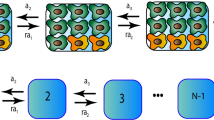Abstract
THE development of cancer following exposure to chemical carcinogens or to various forms of irradiation is almost invariably slow and prolonged. Although the process can be initiated by a brief exposure to a carcinogenic stimulus, there is no evidence that target cells so altered are cancer cells. Rather, there is abundant indirect evidence from many systems that what is induced is an altered cell or cell population from which malignant neoplasia can gradually develop or evolve1,2. Neoplastic development therefore resembles a chain reaction, triggered by exposure to a carcinogen, in which the links are new populations with altered organisational, structural and biochemical properties. These slowly proliferative new lesions are characteristically focal in distribution, implying that only a small proportion of the original target cell population in any organ or tissue participates. It is not known what the critical property (or properties) is that makes initiated cells so important in carcinogens and the failure to understand and manipulate this early step has been a major impediment to its analysis.
Similar content being viewed by others
References
Foulds, L., Neoplastic Development, 1, ch. 3 (Academic, London, 1969).
Farber, E., Cancer Res., 33, 2537–2550 (1973).
Farber, E., Parker, S., and Gruenstein, M., Cancer Res. (in the press).
Gravela, E., Feo, F., Canuto, R. A., Garcea, R., and Gabriel, L., Cancer Res., 35, 3041–3047 (1975).
Cameron, R., Sweeney, G. D., Jones, K., Lee, G., and Farber, E., Cancer Res. (in the press).
Becker, F. F., and Klein, K. M., Cancer Res., 31, 169–173 (1971).
Kitagawa, T., Gann, 62, 217–224 (1971).
Druckrey, H., Stemhoff, D., Preussman, R., and Ivankovic, S., Nature wissenschaften, 50, 735 (1963).
Craddock, V. M., Chem.-Biol. Interact., 10, 313–321 (1975).
Farber, E., Methods in Cancer Res., 7, 345–375 (1973).
Sasaki, T., and Yoshida, I., Virchows Arch. path. Anat. Physiol., 295, 175–300 (1935).
Scherer, E., and Emmelot, P., Eur. J. Cancer, 11, 689–696 (1975).
Haddow, A., Acta Un. Int. Cancr., 3, 342–352 (1938).
Laws, J. D., Br. J. Cancer, 13, 669–674 (1959).
Vasiliev, J. M., Guelstein, V. I., J. natn. Cancer Inst., 31, 1123–1143 (1963).
Diamond, L., Prog. exp. Tumour Res., 11, 364–383 (1969).
Kitagawa, T., Michalopoulis, G., and Pitot, H. C., Cancer Res., 35, 3682–3692 (1975).
Peraino, C., Fry, R. J. M., Staffeldt, E., and Kisieleski, W. E., Cancer Res., 33, 2701–2705 (1973).
Peraino, C., Fry, R. J. M., Staffeldt, E., and Christopher, J. P., Cancer Res., 35, 2884–2890 (1975).
Author information
Authors and Affiliations
Rights and permissions
About this article
Cite this article
SOLT, D., FARBER, E. New principle for the analysis of chemical carcinogenesis. Nature 263, 701–703 (1976). https://doi.org/10.1038/263701a0
Received:
Accepted:
Published:
Issue Date:
DOI: https://doi.org/10.1038/263701a0
- Springer Nature Limited
This article is cited by
-
Aldo-Keto Reductases as Early Biomarkers of Hepatocellular Carcinoma: A Comparison Between Animal Models and Human HCC
Digestive Diseases and Sciences (2018)
-
Macrolide antibiotics differentially influence human HepG2 cytotoxicity and modulate intrinsic/extrinsic apoptotic pathways in rat hepatocellular carcinoma model
Naunyn-Schmiedeberg's Archives of Pharmacology (2017)
-
Ethanol extract of Phellinus merrillii protects against diethylnitrosamine- and 2-acetylaminofluorene-induced hepatocarcinogenesis in rats
Chinese Journal of Integrative Medicine (2017)
-
Multiple resistance to carcinogens and xenobiotics: P-glycoproteins as universal detoxifiers
Archives of Toxicology (2017)
-
Development of a methodology for in vivo follow-up of hepatocellular carcinoma in hepatocyte specific Trim24-null mice treated with myo-inositol trispyrophosphate
Journal of Experimental & Clinical Cancer Research (2016)





